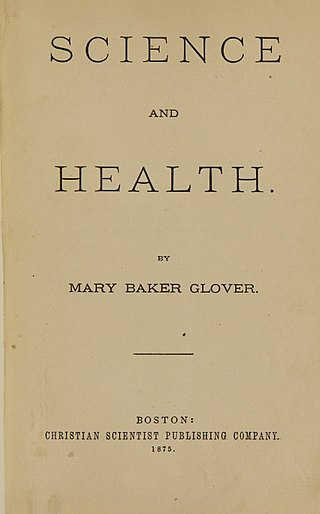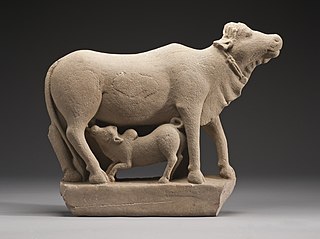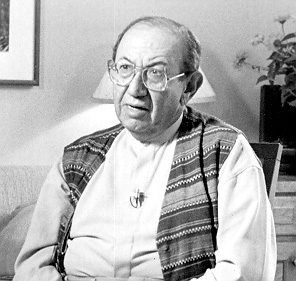Related Research Articles

Sir John Anthony Pople was a British theoretical chemist who was awarded the Nobel Prize in Chemistry with Walter Kohn in 1998 for his development of computational methods in quantum chemistry.

Science and Health with Key to the Scriptures is, along with the Bible, the central text of the Christian Science religion. Mary Baker Eddy described it as her "most important work." She began writing it in February 1872 and the first edition was published in 1875. However, she would continue working on it and making changes for the rest of her life.

John Richard Hersey was an American writer and journalist. He is considered one of the earliest practitioners of the so-called New Journalism, in which storytelling techniques of fiction are adapted to non-fiction reportage. In 1999, Hersey's account of the aftermath of the atomic bomb dropped on Hiroshima, Japan, was adjudged the finest piece of American journalism of the 20th century by a 36-member panel associated with New York University's journalism department.

Due to the multiple benefits from cattle, there are varying beliefs about cattle in societies and religions. In some regions, especially most states of India, the slaughter of cattle is prohibited and their meat may be taboo.

Kamadhenu, also known as Surabhi, is a divine bovine-goddess described in Hinduism as the mother of all cows. She is a miraculous cow of plenty who provides her owner whatever he desires and is often portrayed as the mother of other cattle. In iconography, she is generally depicted as a white cow with a female head and breasts, the wings of a bird, and the tail of a peafowl or as a white cow containing various deities within her body. Kamadhenu is not worshipped independently as a goddess. Rather, she is honored by the Hindu veneration of cows, who are regarded as her earthly embodiments.

Yajna refers in Hinduism to any ritual done in front of a sacred fire, often with mantras. Yajna has been a Vedic tradition, described in a layer of Vedic literature called Brahmanas, as well as Yajurveda. The tradition has evolved from offering oblations and libations into sacred fire to symbolic offerings in the presence of sacred fire (Agni).
Walter Cox McCrone Jr. was an American chemist who worked extensively on applications of polarized light microscopy and is sometimes characterized as the "father of modern microscopy". He was also an expert in electron microscopy, crystallography, ultra-microanalysis, and particle identification. In 1960 he founded the McCrone Research Institute, a non-profit educational and research organization for microscopy based in Chicago.

Daniel Keyes was an American writer who wrote the novel Flowers for Algernon. Keyes was given the Author Emeritus honor by the Science Fiction and Fantasy Writers of America in 2000.
Marvin Harris was an American anthropologist. He was born in Brooklyn, New York City. A prolific writer, he was highly influential in the development of cultural materialism and environmental determinism. In his work, he combined Karl Marx's emphasis on the forces of production with Thomas Malthus's insights on the impact of demographic factors on other parts of the sociocultural system.

Kwame Akroma-Ampim Kusi Anthony Appiah is a philosopher, cultural theorist, and novelist whose interests include political and moral theory, the philosophy of language and mind, and African intellectual history. Appiah was the Laurance S. Rockefeller University Professor of Philosophy at Princeton University, before moving to New York University (NYU) in 2014. He holds an appointment at the NYU Department of Philosophy and NYU's School of Law. Appiah was elected President of the American Academy of Arts and Letters in January 2022.

Anthony Thomas Grafton is an American historian of early modern Europe and the Henry Putnam University Professor of History at Princeton University, where he is also the Director the Program in European Cultural Studies. He is also a corresponding fellow of the British Academy and a recipient of the Balzan Prize. From January 2011 to January 2012, he served as the President of the American Historical Association. From 2006 to 2020, Grafton was co-executive editor of the Journal of the History of Ideas.
İsmet Özel is a Turkish poet and writer.

Since their public debut in August 1945, nuclear weapons and their potential effects have been a recurring motif in popular culture, to the extent that the decades of the Cold War are often referred to as the "atomic age".

Britton "Brit" Chance was an American biochemist, biophysicist, scholar, and inventor whose work helped develop spectroscopy as a way to diagnose medical problems. He was "a world leader in transforming theoretical science into useful biomedical and clinical applications" and is considered "the founder of the biomedical photonics." He received the National Medal of Science in 1974.
Carolina Henriette MacGillavry was a Dutch chemist and crystallographer. She is known for her discoveries on the use of diffraction in crystallography.

John Dombrowski Roberts was an American chemist. He made contributions to the integration of physical chemistry, spectroscopy, and organic chemistry for the understanding of chemical reaction rates. Another characteristic of Roberts' work was the early use of NMR, focusing on the concept of spin coupling.

John Christopher Draper was an American chemist and surgeon. He was a son of multidisciplinary scientist John William Draper and a brother of astronomer Henry Draper.
John Anthony West was an American author and lecturer and a proponent of the Sphinx water erosion hypothesis. His early career was as a copywriter in Manhattan and science fiction writer. He received a Hugo Award Honorable Mention in 1962. After recovering from cancer, West died from pneumonia at the age of 85.

Science is a Sacred Cow is a book written by the chemist Anthony Standen. It was first published in 1950 by E. P. Dutton. It was in print for 40 years. The book argues that some scientists and many teachers of science have "inflated egos" or, in the words of Standen, "a fabulous collective ego, as inflated as a skillfully blown piece of bubble gum". The book was widely reviewed.
Standen is a surname. Notable people with the surname include:
References
- ↑ "Anthony Standen Is Dead at 86; Chemist Who Deflated Pomposity", Wolfgang Saxon, June 25, 1993, The New York Times
- ↑ "Personal Survival:Do we live after death?" (pages 384-399), Biographical info and essay by Standen in The Spirit of Man: Great Stories and Experiences of Spiritual Crisis, Inspiration, and the Joy of Life, Whit Burnett (Ed.), Ayer Publishing, 1969, ISBN 0836900367